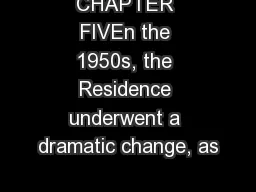PDF-CHAPTER FIVEn the 1950s, the Residence underwent a dramatic change, as
Author : stefany-barnette | Published Date : 2016-12-14
Page 53 Residence Life in the 1950sboom provided new facilities to the University community while simultaneously diminishing the importance of the Residence as a
Presentation Embed Code
Download Presentation
Download Presentation The PPT/PDF document "CHAPTER FIVEn the 1950s, the Residence u..." is the property of its rightful owner. Permission is granted to download and print the materials on this website for personal, non-commercial use only, and to display it on your personal computer provided you do not modify the materials and that you retain all copyright notices contained in the materials. By downloading content from our website, you accept the terms of this agreement.
CHAPTER FIVEn the 1950s, the Residence underwent a dramatic change, as: Transcript
Download Rules Of Document
"CHAPTER FIVEn the 1950s, the Residence underwent a dramatic change, as"The content belongs to its owner. You may download and print it for personal use, without modification, and keep all copyright notices. By downloading, you agree to these terms.
Related Documents














